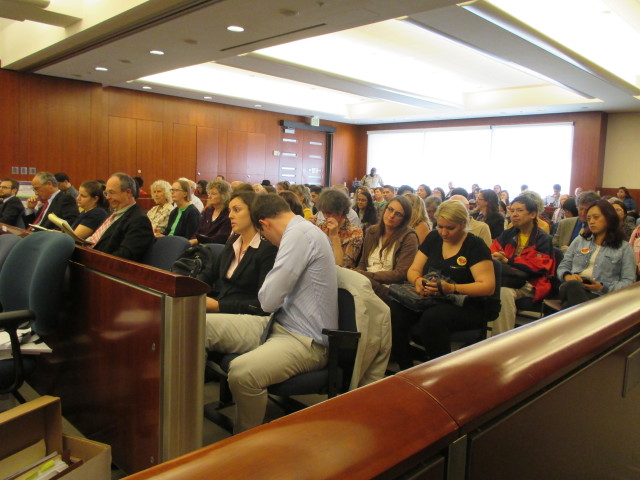
By Tim Redmond
OCTOBER 29, 2014 – The president of the ACCJC tried to climb out of a deep hole this morning as her lawyers sought to undermine the dramatic testimony she had given yesterday.
But evidence introduced later tended to support the claim that Beno had personally intervened to change part of an accrediting report to make it less favorable to City College.
Barbara Beno had testified that City College was not given the type of due process that the ACCJC’s own regulations require. She also admitted to editing the final accrediting report – and that her edits led to the removal of language supportive of the school. After her review, at least two sections in which the visiting team of accreditors had concluded City College was in compliance with the agency’s standards were changed to reflect that the school was out of compliance.
For much of the morning, ACCJC attorney Kenneth Keller sought to help Beno explain what she had meant when she said the school was never given the proper right to respond to the final report calling for termination of its accreditation.
A lot of the discussion became technical and focused on minor semantic issues – specifically, the difference between “deficiencies” and “standards of noncompliance.”

A deficiency, Beno said, is “a behavior that leads to noncompliance.” Under the ACCJC’s rules, if the panel finds new deficiencies after the final report is completed, the school is given adequate time to respond. But if it finds only noncompliance with standards, no such due process is required.
In this case, she said, the panel only found new examples of noncompliance, not new “deficiencies,” so the due-process procedure wasn’t needed.
Help us save local journalism!
Every tax-deductible donation helps us grow to cover the issues that mean the most to our community. Become a 48 Hills Hero and support the only daily progressive news source in the Bay Area.
Deputy City Attorney Ron Flynn asked Beno if the word “deficiency” was ever defined in the ACCJC manual. She said she knew of no such definition.
Beno spend a lot of time talking about her role as a staff member supporting the visiting teams and the commission. The visiting team – whose members are volunteers — evaluates schools, and the chair of that team, chosen by Beno, is ultimately responsible for writing the report that goes to the commission.
In the case of a dramatic decision, like termination, Beno said she always personally reviews the visiting team report.
She said she made edits only for grammar, completeness, clarity, citations, and consistency. In some cases, she said, she made suggestions that the chair of the visiting team rejected.
She also insisted, repeatedly, that the fact that she and City College were on opposite sides on a critical policy issue – state legislation that would have changed the mission of California’s community colleges – had no bearing on her actions related to accreditation.
In fact, she portrayed herself as a fairly minor player in the process, just a staff member who helped the visiting team and the commission reach its own conclusions.
Then the ACCJC called Sandra Serrano, chancellor of the Kern Community College District and chair of the visiting team that evaluated City College both in 2012 and in 2013.
Serrano said that she took full responsibility for the reports that led to the “show cause” sanction and later the termination of accreditation. She chaired both evaluation panels.
She said, as has been previously reported, that her visiting team in 2012 debated two possible sanctions for City College – a warning and probation. The team decided to recommend probation.
It was the full commission that went the step further and put City College into “show cause” status, the step that led to the loss of accreditation.
In fact, Serrano said that she didn’t think City College should have lost its accreditation and noted that the school had made tremendous progress toward coming into compliance with the ACCJC standards.
“The team did its work and made a recommendation. The commission felt differently,” she testified.
She said that Beno had offered some suggestions on the 2012 report, but downplayed the president’s role in driving the results.
Under cross examination by Deputy City Attorney Matt Goldberg, Serrano acknowledged that she and her team had never discussed show-cause sanctions, and that the people who actually went to the campus and spend five days evaluating every element of City College were convinced that the school could come into full compliance in two years.
“You recommended probation and discussed warning,” he asked. “Was there any discussion of show cause?”
“No,” she said.
Then it got interesting.
The timing of the accreditation, and the changes that were made in the various versions of the reports, is confusing. But the testimony made clear that in the spring of 2013, the ACCJC visiting team and staff were meeting and discussing the extent of the proposed sanctions, and thus the future of City College.
By May, 2013 the visiting team had finished its work, including a couple of conference calls to iron out last-minute issues, and Serrano had sent a final draft to the commission – or at least, to Beno – for editing.
On May 8, at 11:02am, Beno sent an email to Serrano with a list of suggested changes. Among them were the suggestions that the language praising City College for its efforts to comply with the standards be removed, and that two areas in which the team found the school in compliance be changed to non-compliance.
The email, presented as evidence in court, included the following language from Beno:
“Please try to make the suggested changes.”
Q: “After that, you made changes to the report, right?”
A: “Yes.”
In fact, the exchange showed, in at least three areas, Serrano’s draft report had showed City College in compliance, but the edited version showed the school out of compliance.
More interesting: Serrano and Beno both insisted that the reports were based on substantial input from all team members, and Serrano made clear that she would always run substantial changes by her colleagues. The final document, she said, reflected the consensus views of the entire team.
But in this case, Serrano sent her final version, including Beno’s changes, back to the ACCJC at 9:51pm the same day.
Q: “Was there any input from the rest of the team on May 8?”
A: “I don’t recall.”
Goldberg reminded Serrano that during an earlier deposition, she had produced some 7,000 pages of records showing all of her emails and communications with staff and other visiting team members. There were no records showing any communication May 8.
Serrano’s response: “I don’t know.”
The final witness of the day was Krista Johns, who is vice-president for policy and research for the ACCJC. The discussion focused mostly on an issue that even the federal Department of Education found problematic: the number of academics – that is, teachers – who served on the evaluation panel.
Everyone seems to agree that there ought to be people on an accreditation team who are classroom instructors and thus understand the basic issue – are students learning? Is the quality of teaching up to par?
But the ACCJC has a rather expansive vision of how you define an “academic.” According to Johns, every accrediting agency adopts its own definition of teaching; in the case of the ACCJC, deans, department chairs, vice-presidents, and even student-services administrators could count as academics.
The DOE, responding to a complaint from the teachers’ union, ruled that only one real academic was included on the City College accrediting panel. But Seranno claimed that, for example, a vice-president for academic affairs at an Oklahoma community college, a dean of planning at Sacramento City College, and a dean of instruction at Laney College should count as teachers.
This is a key issue, since nobody disputes that the quality of education – actual classroom learning – is exceptional at City College. And the thrust of the ACCJC’s criticism of the school focused on non-classroom issues – among them the lack of enough administrators.
It’s true that many deans and vice presidents were once classroom teachers, and some still teach a few courses. But many, if not most, college administrators once spent time in the classroom – and when they become administrators, they have a different job and perspective.
For the ACCJC to say that someone who has the credential to be an academic – even if that person no longer teaches and now has the training and perspective of an administrator – counts as a teacher is a bit of a stretch.
In some ways, the most dramatic element of the trial happened away from the bar and the bench. The room, once again, was packed – and today, a wide range of community organizations were present.
Members of the Chinese Progressive Association showed up, along with some students from International High School. So did Young Workers United, SEIU Local 1021, and many City College students.
Judge Curtis Karnow will be deciding the case on the facts, the law, and the testimony. Be he can hardly miss the outpouring of support for a community institution that is packing his courtroom to capacity every day.




